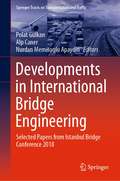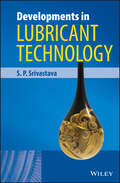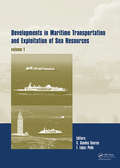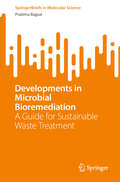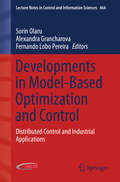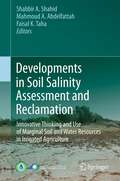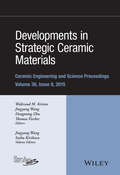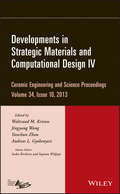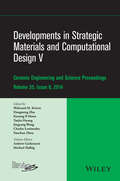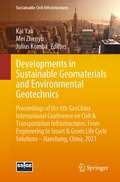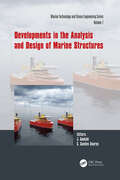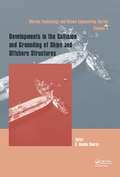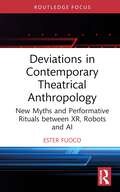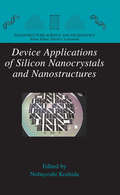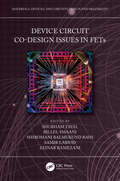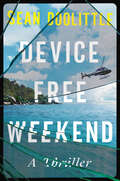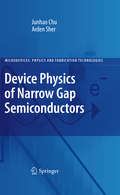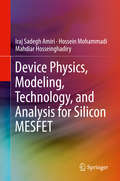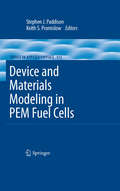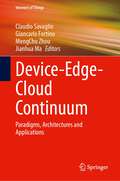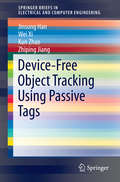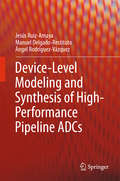- Table View
- List View
Developments in International Bridge Engineering: Selected Papers from Istanbul Bridge Conference 2018 (Springer Tracts on Transportation and Traffic #17)
by Alp Caner Polat Gülkan Nurdan Memisoglu ApaydinThis book reports on current challenges in bridge engineering faced by professionals around the globe, giving a special emphasis to recently developed techniques and methods for bridge design, construction and monitoring. Based on extended and revised papers selected from outstanding presentation at the Istanbul Bridge Conference 2018, held from November 5 – 6, 2018, in Istanbul, Turkey, and by highlighting major bridge studies, spanning from numerical and modeling studies to the applications of new construction techniques and monitoring systems, this book is intended to promote high standards in modern bridge engineering. It offers a timely reference to both academics and professionals in this field.
Developments in Lubricant Technology
by S. P. SrivastavaProvides a fundamental understanding of lubricants and lubricant technology including emerging lubricants such as synthetic and environmentally friendly lubricants * Teaches the reader to understand the role of technology involved in the manufacture of lubricants * Details both major industrial oils and automotive oils for various engines * Covers emerging lubricant technology such as synthetic and environmentally friendly lubricants * Discusses lubricant blending technology, storage, re-refining and condition monitoring of lubricant in equipment
Developments in Maritime Transportation and Exploitation of Sea Resources: IMAM 2013
by C. Guedes Soares F. López PeñaCovering recent developments in maritime transportation and exploitation of sea resources, encompassing ocean and coastal areas, this book is intended for academics and professionals involved in the development of marine transportation and the exploitation of sea resources.
Developments in Microbial Bioremediation: A Guide for Sustainable Waste Treatment (SpringerBriefs in Molecular Science)
by Pratima BajpaiThis book sheds new light on the transformative role of microorganisms in waste management, offering a comprehensive overview of microbial waste management strategies and their applications. Through this book, readers will learn about the latest advancements in bioremediation and microbial consortia technology, providing a fresh perspective on sustainable waste treatment solutions. The chapters cover topics such as the types and origins of waste, the importance of microorganisms in various waste management processes, and the benefits of bioremediation compared to traditional methods. Readers will discover diverse strategies for managing microbial waste, including bioleaching, bioaugmentation, and utilizing microorganisms to aid phytoremediation. The book also discusses the combined use of bacteria and microalgae for wastewater treatment and emerging innovations in microbial consortia technology. Critical attention is given to the role of microbes in multiple industrial applications such as pharmaceuticals, food processing, textiles, explosives, distilleries, and petrochemicals. Additionally, it explores bioinformatics approaches like genomics and proteomics that drive bioremediation efforts. This volume is an essential resource for researchers in environmental science, biotechnology professionals focusing on sustainable practices, scholars studying advanced wastewater treatment methods using nanotechnology or plant species integration with microorganisms. It invites readers to think through critical questions about sustainable waste treatment practices while offering valuable insights into future perspectives on microbial waste management.
Developments in Model-Based Optimization and Control
by Sorin Olaru Alexandra Grancharova Fernando Lobo PereiraThis book deals with optimization methods as tools for decision making and control in the presence of model uncertainty. It is oriented to the use of these tools in engineering, specifically in automatic control design with all its components: analysis of dynamical systems, identification problems, and feedback control design. Developments in Model-Based Optimization and Control takes advantage of optimization-based formulations for such classical feedback design objectives as stability, performance and feasibility, afforded by the established body of results and methodologies constituting optimal control theory. It makes particular use of the popular formulation known as predictive control or receding-horizon optimization. The individual contributions in this volume are wide-ranging in subject matter but coordinated within a five-part structure covering material on: · complexity and structure in model predictive control (MPC); · collaborative MPC; · distributed MPC; · optimization-based analysis and design; and · applications to bioprocesses, multivehicle systems or energy management. The various contributions cover a subject spectrum including inverse optimality and more modern decentralized and cooperative formulations of receding-horizon optimal control. Readers will find fourteen chapters dedicated to optimization-based tools for robustness analysis, and decision-making in relation to feedback mechanisms--fault detection, for example--and three chapters putting forward applications where the model-based optimization brings a novel perspective. Developments in Model-Based Optimization and Control is a selection of contributions expanded and updated from the Optimisation-based Control and Estimation workshops held in November 2013 and November 2014. It forms a useful resource for academic researchers and graduate students interested in the state of the art in predictive control. Control engineers working in model-based optimization and control, particularly in its bioprocess applications will also find this collection instructive.
Developments in Multidimensional Spatial Data Models
by Alias Abdul Rahman Christopher Gold Mohamad Nor Said Pawel BoguslawskiThis book presents the latest research developments in geoinformation science, which includes all the sub-disciplines of the subject, such as: geomatic engineering, GIS, remote sensing, digital photogrammetry, digital cartography, etc.
Developments in Soil Salinity Assessment and Reclamation
by Shabbir A. Shahid Mahmoud A. Abdelfattah Faisal K. TahaThe papers assembled here cover topics such as technological advances in soil salinity mapping and monitoring, management and reclamation of salt-affected soils, use of marginal quality water for crop production, salt-tolerance mechanisms in plants, biosaline agriculture and agroforestry, microbiological interventions for marginal soils, opportunities and challenges in using marginal waters, and soil and water management in irrigated agriculture.
Developments in Strategic Ceramic Materials
by Thomas Fischer Soshu Kirihara Waltraud M. Kriven Jingyang Wang Dongming ZhuThe Ceramic Engineering and Science Proceeding has been published by The American Ceramic Society since 1980. This series contains a collection of papers dealing with issues in both traditional ceramics (i.e., glass, whitewares, refractories, and porcelain enamel) and advanced ceramics. Topics covered in the area of advanced ceramic include bioceramics, nanomaterials, composites, solid oxide fuel cells, mechanical properties and structural design, advanced ceramic coatings, ceramic armor, porous ceramics, and more.
Developments in Strategic Ceramic Materials II: Ceramic Engineering and Science Proceedings Volume 37, Issue 7
by Waltraud M. Kriven Jingyang Wang Yanchun Zhou Dongming Zhu Manabu Fukushima Andrew Gyekenyesi Gustavo CostaThis issue contains 27 papers from The American Ceramic Society’s 40th International Conference on Advanced Ceramics and Composites, held in Daytona Beach, Florida, January 24-29, 2016. This issue includes papers presented in the following Symposia and Focused Sessions: Symposium 2 – Advanced Ceramic Coatings for Structural, Environmental, and Functional Applications; Symposium 10 – Virtual Materials (Computational) Design and Ceramic Genome; Symposium 11 – Advanced Materials and Innovative Processing Ideas for the Industrial Root Technology; Symposium 12 – Materials for Extreme Environments: Ultrahigh Temperature Ceramics; and Emerging Technologies Symposium–Carbon Nanostructures; and Focused Session 1 - Geopolymers and Chemically Bonded Ceramics.
Developments in Strategic Materials and Computational Design IV
by Soshu Kirihara Sujanto Widjaja Waltraud M. Kriven Jingyang Wang Yanchun Zhou Andrew GyekenyesiCeramic Engineering and Science Proceedings Volume 34, Issue 10 - Developments in Strategic Materials and Computational Design IV A collection of 25 papers from The American Ceramic Society’s 37th International Conference on Advanced Ceramics and Composites, held in Daytona Beach, Florida, January 27-February 1, 2013. This issue includes papers presented in the Geopolymers and Chemically Bonded Ceramics (Focused Session 1); Thermal Management Materials and Technologies (Focused Sessoin 2); and Materials for Extreme Environments: Ultrahigh Temperature Ceramics and Nano-laminated Ternary Carbides and Nitrides (MAX Phases) (Symposium 12).
Developments in Strategic Materials and Computational Design V
by Waltraud M. Kriven Jingyang Wang Yanchun Zhou Taejin Hwang Michael Halbig Kyoung Il Moon Charles A. Lewinsohn Dongming Zhu Andrew GyekenyesiThis issue contains 31 papers from The American Ceramic Society’s 38th International Conference on Advanced Ceramics and Composites, held in Daytona Beach, Florida, January 26-31, 2014. This issue includes papers presented in the following Symposia and Focused Sessions: Symposium 2 – Advanced Ceramic Coatings for Structural, Environmental, and Functional Applications; Symposium 10 – Virtual Materials (Computational) Design and Ceramic Genome; Symposium 11 – Advanced Materials and Innovative Processing Ideas for the Industrial Root Technology; Symposium 12 – Materials for Extreme Environments: Ultrahigh Temperature Ceramics and Nanolaminated Ternary Carbides and Nitrides; Focused Session 1 - Geopolymers and Chemically Bonded Ceramics; Focused Session 2 – Advanced Ceramic Materials and Processing for Photonics and Energy; Focused Session 3 – Rare Earth Oxides for Energy, Optical and Biomedical Applications, Focused Session 4 – Ion-Transport Membranes; 3rd Global Pacific Rim Engineering Ceramics Summit; and the 3rd Annual Global Young Investigator Forum
Developments in Sustainable Geomaterials and Environmental Geotechnics: Proceedings of the 6th GeoChina International Conference on Civil & Transportation Infrastructures: From Engineering to Smart & Green Life Cycle Solutions -- Nanchang, China, 2021 (Sustainable Civil Infrastructures)
by Kai Yao Mei Zhenyu Julius KombaThe current trends in Geotechnical Engineering are moving towards sustainable design and construction. Studies presented in this volume present recent research findings and critically review the existing literature related to assessment of sustainable geomaterials and environmental geotechnics. Special emphasise is given to the material characterization on industry by product or newly developed sustainable materials in geotechnical engineering or pavement engineering. This volume is based on contributions to the 6th GeoChina International Conference on Civil & Transportation Infrastructures: From Engineering to Smart & Green Life Cycle Solutions -- Nanchang, China, 2021.
Developments in the Analysis and Design of Marine Structures: Proceedings of the 8th International Conference on Marine Structures (MARSTRUCT 2021, 7-9 June 2021, Trondheim, Norway) (Proceedings in Marine Technology and Ocean Engineering)
by J. AmdahlDevelopments in the Analysis and Design of Marine Structures is a collection of papers presented at MARSTRUCT 2021, the 8th International Conference on Marine Structures (by remote transmission, 7-9 June 2021, organised by the Department of Marine Technology of the Norwegian University of Science and Technology, Trondheim, Norway), and is essential reading for academics, engineers and professionals involved in the design of marine and offshore structures. The MARSTRUCT Conference series deals with Ship and Offshore Structures, addressing topics in the fields of: - Methods and Tools for Loads and Load Effects; - Methods and Tools for Strength Assessment; - Experimental Analysis of Structures; - Materials and Fabrication of Structures; - Methods and Tools for Structural Design and Optimisation; and - Structural Reliability, Safety and Environmental Protection. The MARSTRUCT conferences series of started in Glasgow, UK in 2007, the second event of the series took place in Lisbon, Portugal in March 2009, the third in Hamburg, Germany in March 2011, the fourth in Espoo, Finland in March 2013, the fifth in Southampton, UK in March 2015, the sixth in Lisbon, Portugal in May 2017, and the seventh in Drubovnik, Croatia in May 2019. The ‘Proceedings in Marine Technology and Ocean Engineering’ series is dedicated to the publication of proceedings of peer-reviewed international conferences dealing with various aspects of ‘Marine Technology and Ocean Engineering’. The Series includes the proceedings of the following conferences: the International Maritime Association of the Mediterranean (IMAM) conferences, the Marine Structures (MARSTRUCT) conferences, the Renewable Energies Offshore (RENEW) conferences and the Maritime Technology (MARTECH) conferences. The ‘Marine Technology and Ocean Engineering’ series is also open to new conferences that cover topics on the sustainable exploration and exploitation of marine resources in various fields, such as maritime transport and ports, usage of the ocean including coastal areas, nautical activities, the exploration and exploitation of mineral resources, the protection of the marine environment and its resources, and risk analysis, safety and reliability. The aim of the series is to stimulate advanced education and training through the wide dissemination of the results of scientific research.
Developments in the Collision and Grounding of Ships and Offshore Structures: Proceedings of the 8th International Conference on Collision and Grounding of Ships and Offshore Structures (ICCGS 2019), 21-23 October, 2019, Lisbon, Portugal (Proceedings in Marine Technology and Ocean Engineering)
by Carlos Guedes SoaresDevelopments in the Collision and Grounding of Ships and Offshore includes the contributions to the 8th International Conference on Collision and Grounding of Ships and Offshore Structures (ICCGS 2019, Lisbon, Portugal, 21-23 October 2019). The series of ICCGS-conferences started in 1996 in San Francisco, USA, and are organised every three years in Europe, Asia and the Americas. Developments in the Collision and Grounding of Ships and Offshore covers a wide range of topics, from the behavior of large passenger vessels in collision and grounding, collision and grounding in arctic conditions including accidental ice impact, stability residual strength and oil outflow of ships after collision or grounding, collision and grounding statistics and predictions and measures of the probability of incidents, risk assessment of collision and grounding, prediction and measures for reduction of collision and grounding, new designs for improvement of structural resistance to collisions, analysis of ultimate strength of ship structures (bulkheads, tank tops, shell etc.), design of buffer bows to reduce collision consequences, design of foreship structures of ferries with doors to avoid water ingress in case of a collision, development of rational rules for the structural design against collision and grounding, innovative navigation systems for safer sea transportation, the role of IMO, classification societies, and other regulatory bodies in developing safer ships, collision between ships and offshore structures, collision between ships and fixed or floating bridges and submerged tunnels, collision with quays and waterfront structures, collision and grounding experiments, properties of marine-use materials under impact loadings, residual strength of damaged ships and offshore structures, analysis of ultimate strength of ship structures, to human factors in collision and grounding accidents. Developments in the Collision and Grounding of Ships and Offshore is a valuable resource for academics, engineers and professionals involved in these areas.
Deviations in Contemporary Theatrical Anthropology: New Myths and Performative Rituals between XR, Robots and AI (ISSN)
by Ester FuocoThis book refers to the artistic deviation from dominant goals in a social system or from means considered legitimate in that system.This book explores a "New Humanism" in the performing arts, unique in the sense of human's ability to co-create and communicate beyond spatial and temporal boundaries, wars, and pandemics, through artistic deviations carried out by machines and through the Extended Reality. Through the lens of anthropology and aesthetics, this study selects useful case studies to demonstrate this phenomenon of performative symphonises, in which the experimentation of AI-driven creativity and the new human-robot interaction (HRI) lead to philosophical inquiries about the nature of creativity, intelligence, and the definition of art itself. These shifts in paradigms invite us to reconsider established concepts and explore new perspectives on the relationship between technology, art, and the human experience.This book will be of great interest to students and scholars in theatre and performance studies, anthropology, and digital humanities.
Device Applications of Silicon Nanocrystals and Nanostructures
by Nobuyoshi KoshidaRecent developments in the technology of silicon nanocrystals and silicon nanostructures, where quantum-size effects are important, are systematically described including examples of device applications. Due to the strong quantum confinement effect, the material properties are freed from the usual indirect- or direct-bandgap regime, and the optical, electrical, thermal, and chemical properties of these nanocrystalline and nanostructured semiconductors are drastically changed from those of bulk silicon. In addition to efficient visible luminescence, various other useful material functions are induced in nanocrystalline silicon and periodic silicon nanostructures. Some novel devices and applications, in fields such as photonics (electroluminescence diode, microcavity, and waveguide), electronics (single-electron device, spin transistor, nonvolatile memory, and ballistic electron emitter), acoustics, and biology, have been developed by the use of these quantum-induced functions in ways different from the conventional scaling principle for ULSI.
Device Architecture and Materials for Organic Light-Emitting Devices
by Sarah ScholsDevice Architecture and Materials for Organic Light-Emitting Devices focuses on the design of new device and material concepts for organic light-emitting devices, thereby targeting high current densities and an improved control of the triplet concentration. A new light-emitting device architecture, the OLED with field-effect electron transport, is demonstrated. This device is a hybrid between a diode and a field-effect transistor. Compared to conventional OLEDs, the metallic cathode is displaced by one to several micrometers from the light-emitting zone, reducing optical absorption losses. The electrons injected by the cathode accumulate at an organic heterojunction and are transported to the light-emission zone by field-effect. High mobilities for charge carriers are achieved in this way, enabling a high current density and a reduced number of charge carriers in the device. Pulsed excitation experiments show that pulses down to 1 µs can be applied to this structure without affecting the light intensity, suggesting that pulsed excitation might be useful to reduce the accumulation of triplets in the device. The combination of all these properties makes the OLED with field-effect electron transport particularly interesting for waveguide devices and future electrically pumped lasers. In addition, triplet-emitter doped organic materials, as well as the use of triplet scavengers in conjugated polymers are investigated.
Device Circuit Co-Design Issues in FETs (Materials, Devices, and Circuits)
by Béatrice HendrichThis book provides an overview of emerging semiconductor devices and their applications in electronic circuits, which form the foundation of electronic devices. Device Circuit Co-Design Issues in FETs provides readers with a better understanding of the ever-growing field of low-power electronic devices and their applications in the wireless, biosensing, and circuit domains. The book brings researchers and engineers from various disciplines of the VLSI domain together to tackle the emerging challenges in the field of engineering and applications of advanced low-power devices in an effort to improve the performance of these technologies. The chapters examine the challenges and scope of FinFET device circuits, 3D FETs, and advanced FET for circuit applications. The book also discusses low-power memory design, neuromorphic computing, and issues related to thermal reliability. The authors provide a good understanding of device physics and circuits, and discuss transistors based on the new channel/dielectric materials and device architectures to achieve low-power dissipation and ultra-high switching speeds to fulfill the requirements of the semiconductor industry. This book is intended for students, researchers, and professionals in the field of semiconductor devices and nanodevices, as well as those working on device-circuit co-design issues.
Device Free Weekend
by Sean DoolittleSeven friends, one eccentric billionaire, and an all-expenses-paid reunion on a private island: with no technology allowed, it&’ll be a weekend to remember—for those who make it out alive. Ryan Cloverhill, founder and CEO of the world&’s most popular social media platform, invites his six best friends from college to his home on his private island near Puget Sound. For Stephen, Emma, Perry, Will, Beau, and Lainie, day one is just what the doctor ordered: amazing food, many drinks, lots of laughter, and a sunset cruise around the island aboard their host&’s custom Van Dutch 55. Day Two, however, takes a bewildering turn when the six hungover guests wake up to find that their host has disappeared, along with all connection to the mainland. A touchscreen tablet of unknown make awaits them, blatantly defying the rules of the weekend with its on-screen challenge: Unlock Me! The passcode to the tablet is hidden somewhere in the group&’s shared history. But what seems at first like just another silly game turns deadly serious when the group discovers what unlocking the tablet really means. Is it the key to their futures, a Pandora&’s box none of them will ever be able to close, or both? Only one thing is clear: their old friend Ryan has something unthinkable planned. Now it&’s up to the six of them to stop him. And when this weekend is over, the world will never be the same.
Device Physics of Narrow Gap Semiconductors
by Arden Sher Junhao ChuNarrow gap semiconductors obey the general rules of semiconductor science, but often exhibit extreme features of these rules because of the same properties that produce their narrow gaps. Consequently these materials provide sensitive tests of theory, and the opportunity for the design of innovative devices. Narrow gap semiconductors are the most important materials for the preparation of advanced modern infrared systems. Device Physics of Narrow Gap Semiconductors, a forthcoming second book, offers descriptions of the materials science and device physics of these unique materials. Topics covered include impurities and defects, recombination mechanisms, surface and interface properties, and the properties of low dimensional systems for infrared applications. This book will help readers to understand not only semiconductor physics and materials science, but also how they relate to advanced opto-electronic devices. The final chapter describes the device physics of photoconductive detectors, photovoltaic infrared detectors, super lattices and quantum wells, infrared lasers, and single photon infrared detectors.
Device Physics, Modeling, Technology, and Analysis for Silicon MESFET
by Iraj Sadegh Amiri Hossein Mohammadi Mahdiar HosseinghadiryThis book provides detailed and accurate information on the history, structure, operation, benefits and advanced structures of silicon MESFET, along with modeling and analysis of the device. The authors explain the detailed physics that are important in modeling of SOI-MESFETs, and present the derivations of compact model expressions so that users can recognize the physical meaning of the model equations and parameters. The discussion also includes advanced structures for SOI-MESFET for submicron applications.
Device and Materials Modeling in PEM Fuel Cells
by Stephen J. Paddison Keith S. PromislowThe impact of proton exchange membrane (PEM) fuel cells on energy generation will parallel the impact of the integrated circuit on information technology. The underlying processes in PEM fuel cells have strong ties to energy generation at the mitochondrial level in organic life. The potential applications range from the micron scale to large scale industrial production. Successful integrated of PEM fuel cells into the mass-market will require new materials and a deepening understanding of the balance required to maintain the various operational states. Key areas of development include electrocatalysts for the fuel and air electrodes and membranes exhibiting good proton conductivity under minimal hydration and temperatures between -20 °C to 120 °C. New materials possessing improved properties will emerge as a result of a collaborative effort between experimentalists, engineers, and theorists, the latter doing both device and materials modeling. This book presents a series of contributed articles from scientists who have made a contribution in the modeling of fuel cells from either a device or materials perspective. As fuel cell technologies are an emerging area this book will be of interest to any working in this field. This book will provide a survey (with significant depth) of virtually all the computational and modeling work done in this area.
Device-Edge-Cloud Continuum: Paradigms, Architectures and Applications (Internet of Things)
by Giancarlo Fortino Jianhua Ma MengChu Zhou Claudio SavaglioThis book focuses on both theoretical and practical aspects of the “Device-Edge-Cloud continuum”, a development approach aimed at the seamless provision of next-generation cyber-physical services through the dynamic orchestration of heterogeneous computing resources, located at different distances to the user and featured by different peculiarities (high responsiveness, high computing power, etc.). The book specifically explores recent advances in paradigms, architectures, models, and applications for the “Device-Edge-Cloud continuum”, which raises many 'in-the-small' and 'in-the-large' issues involving device programming, system architectures and methods for the development of IoT ecosystem. In this direction, the contributions presented in the book propose original solutions and aim at relevant domains spanning from healthcare to industry, agriculture and transportation.
Device-Free Object Tracking Using Passive Tags
by Jinsong Han Wei Xi Kun Zhao Zhiping JiangThis SpringerBrief examines the use of cheap commercial passive RFID tags to achieve accurate device-free object-tracking. It presents a sensitive detector, named Twins, which uses a pair of adjacent passive tags to detect uncooperative targets (such as intruders). Twins leverages a newly observed phenomenon called critical state that is caused by interference among passive tags. The author expands on the previous object tracking methods, which are mostly device-based, and reveals a new interference model and their extensive experiments for validation. A prototype implementation of the Twins-based intrusion detection scheme with commercial off-the-shelf reader and tags is also covered in this SpringerBrief. Device-Free Object Tracking Using Passive Tags is designed for researchers and professionals interested in smart sensing, localization, RFID and Internet of Things applications. The content is also useful for advanced-level students studying electrical engineering and computer science.
Device-Level Modeling and Synthesis of High-Performance Pipeline ADCs
by Jesús Ruiz-Amaya Ángel Rodríguez-Vázquez Manuel Delgado-RestitutoThis book presents models and procedures to design pipeline analog-to-digital converters, compensating for device inaccuracies, so that high-performance specs can be met within short design cycles. These models are capable of capturing and predicting the behavior of pipeline data converters within less than half-a-bit deviation, versus transistor-level simulations. As a result, far fewer model iterations are required across the design cycle. Models described in this book accurately predict transient behaviors, which are key to the performance of discrete-time systems and hence to the performance of pipeline data converters.
